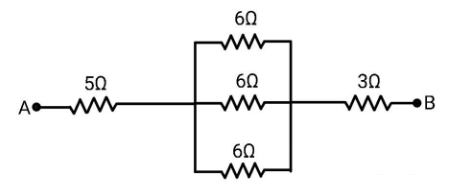
Find the effective resistance between A and B


Answer
468.3k+ views
2 likes
Hint: Here, we are supposed to find the effective resistance between the point A and B, meaning that we are supposed to find a value of single resistance which will offer equal resistance as offered by the combination of these five resistors. A circuit might contain a number of resistors but in most of the cases, the circuit can be reduced and the number of resistors can be decreased by equivalent resistors. The reduction can be obtained by finding series and parallel combinations of resistors.
Complete step by step answer:
Whenever you want to find if the resistors are connected in series or in parallel, always go for the end points of the resistors. Consider two resistors, if one end of each resistor is connected at the same point, you say that the resistors are connected in series and if both the ends of the resistors meet at the same point, then you say that the resistors are connected in parallel. Now, observe the figure given in the question, you can see that the ends of all the
When a parallel combination of
Now, you can observe that the
Hence, the effective resistance between point A and B is
Note: Make sure that you keep in mind the method of reducing the circuit having resistances to its lowest form, it may be a case where the resistances are connected in series, or say in parallel and it may be the case where the resistances are connected as a combination of series and parallel. Keep in mind how the equivalent/effective value of resistance is obtained in case of series and parallel. In series, the effective resistance is simply the sum of resistances and in parallel the reciprocal of the effective resistance is equal to the sum of the reciprocals of each resistance.
Complete step by step answer:
Whenever you want to find if the resistors are connected in series or in parallel, always go for the end points of the resistors. Consider two resistors, if one end of each resistor is connected at the same point, you say that the resistors are connected in series and if both the ends of the resistors meet at the same point, then you say that the resistors are connected in parallel. Now, observe the figure given in the question, you can see that the ends of all the
When a parallel combination of
Now, you can observe that the
Hence, the effective resistance between point A and B is
Note: Make sure that you keep in mind the method of reducing the circuit having resistances to its lowest form, it may be a case where the resistances are connected in series, or say in parallel and it may be the case where the resistances are connected as a combination of series and parallel. Keep in mind how the equivalent/effective value of resistance is obtained in case of series and parallel. In series, the effective resistance is simply the sum of resistances and in parallel the reciprocal of the effective resistance is equal to the sum of the reciprocals of each resistance.
Recently Updated Pages
Master Class 4 Maths: Engaging Questions & Answers for Success

Master Class 4 English: Engaging Questions & Answers for Success

Master Class 4 Science: Engaging Questions & Answers for Success

Class 4 Question and Answer - Your Ultimate Solutions Guide

Master Class 11 Economics: Engaging Questions & Answers for Success

Master Class 11 Business Studies: Engaging Questions & Answers for Success

Trending doubts
Give 10 examples of unisexual and bisexual flowers

Draw a labelled sketch of the human eye class 12 physics CBSE

Differentiate between homogeneous and heterogeneous class 12 chemistry CBSE

a Tabulate the differences in the characteristics of class 12 chemistry CBSE

Why is the cell called the structural and functional class 12 biology CBSE

Differentiate between insitu conservation and exsitu class 12 biology CBSE




